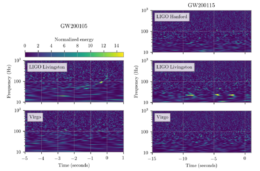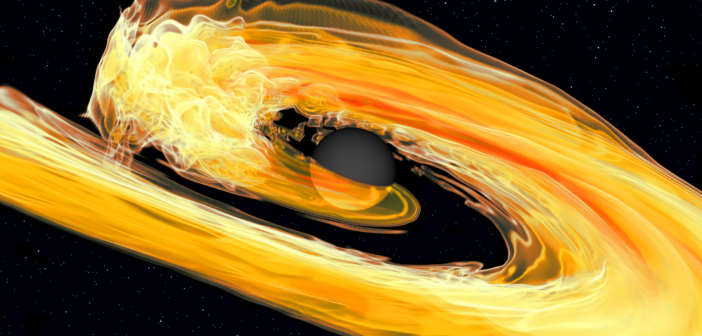In the past six years, we’ve observed black holes merging with black holes and neutron stars colliding with neutron stars. Now, the universe is mixing things up: we’ve finally made the first definitive detection of a black hole merging with a neutron star.
What We’d Previously Seen

The rapidly expanding “stellar graveyard”, a plot that shows the masses of compact objects observed via gravitational waves and other means. GW200105 and GW200115 are highlighted toward the center of the collection. Click to enlarge. [LIGO-Virgo/Frank Elavsky, Aaron Geller/Northwestern]
Now, the LIGO/Virgo collaboration is releasing some of the first results from the second half of its third observing run (O3b) — and these results include two detections of a black-hole-mass object colliding with a neutron-star-mass object.
What Was Found
Using the LIGO detectors in Livingston and Hanford and the Virgo detector in Europe, the collaboration spotted two separate events spaced 10 days apart:
- GW200105 was detected by LIGO Livingston and Virgo (LIGO Hanford was temporarily offline at the time), and the signal is consistent with a black hole of 9 solar masses colliding with a neutron star of 1.9 solar masses.
- GW200115 was detected by all three LIGO/Virgo detectors, and the signal is consistent with a black hole of 6 solar masses colliding with a neutron star of 1.5 solar masses.

The gravitational-wave signals in each detector for GW200105 and GW200115. Click to enlarge. [Abbott et al. 2021]
Without electromagnetic evidence to prove that the secondaries of these two events were neutron stars, we instead rely on our measurements of the masses from the gravitational-wave signals. Comparing these measurements to the masses of known neutron stars in our galaxy, it’s clear that the secondaries both fall comfortably in the expected range of masses for neutron stars.
What We Can Learn from This
While scientists are excited to have finally completed “the family picture” of compact object mergers, GW200105 and GW200115 are more than a milestone — they also carry valuable information.
First, the combination of these two signals has allowed scientists to start estimating the rate of black hole–neutron star mergers. Assuming GW200105 and GW200115 are representative of the broader population, the authors infer that ~12–120 of these mergers occur per Gpc3 per year (that’s roughly one per month within a distance of a billion light-years).

Still from a simulation showing how black holes might interact in the chaotic cores of globular clusters. Black holes are expected to dominate these dense cores, so black hole–neutron star collisions are rarer via this formation channel. [Carl Rodriguez/Northwestern Visualization]
It’s too early to draw strong conclusions, however, and we’ll be able to better understand the relative contributions of these different channels as we make more detections of black hole–neutron star binaries in the future! With KAGRA recently online and LIGO/Virgo soon returning with additional upgrades, we can hope for many more such discoveries ahead as we continue to expand our view of the gravitational-wave universe.
Citation
“Observation of Gravitational Waves from Two Neutron Star–Black Hole Coalescences,” Abbott et al. 2021, ApJL, 915, L5. doi:10.3847/2041-8213/ac082e

